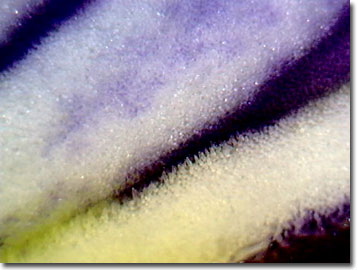Reflected Light Digital Image Gallery
Wild Iris (Iris species)
Irises are among the easiest of the perennials to grow from a rhizome. Long in cultivation, there are literally hundreds of varieties on the market, with new cultivars continually being developed by avid horticulturists.

View a second image of a wild Iris (Iris species).
In North America, there are about 50 species of native iris, all in the subgenus Limniris. Differing from their bearded cultivated cousins, these true irises have smaller, beardless inflorescences. In Florida there are five described native species, and in Leon County, where this unidentified wild iris was collected, two species (the Dixie, or prairie, iris (I. hexagona) and the naturalized paleyellow iris (I. pseudoacorus) grow in the wild. Cultivated species have also escaped and become naturalized, particularly in areas densely populated, as in the city limits of Tallahassee, and downstream of longtime nurseries.
As a perennial herb, the Prairie iris prefers wetlands and acidic soils, as do many wild members of the family Iridaceae (irises). They range from Texas to Florida, Georgia, and South Carolina and up the Mississippi River Valley into Missouri. For wetland determinations, seven species of wild irises in Florida are used as indicator species. Iris flowers typically occur in shades of purple, blue, or white. Irises are monocots, and before human disturbance, species were maintained with no known hybridization. However, in areas such as the Gulf Coast, including Florida, hybridization between the salt-tolerant, sun-loving Prairie iris and Iris fulva, a bottomland freshwater species, is occurring. In areas where extensive timber harvesting, soil transportation, water mining and diversion, damming of rivers, and other habitat disruption has occurred, many types of intermediates are commonly found. With the habitat disturbance, ecological isolation has disintegrated, and genetic introgression is occurring, creating fertile viable hybrids, and backcrosses of many types.
Contributing Authors
Cynthia D. Kelly, Thomas J. Fellers and Michael W. Davidson - National High Magnetic Field Laboratory, 1800 East Paul Dirac Dr., The Florida State University, Tallahassee, Florida, 32310.
BACK TO THE REFLECTED LIGHT IMAGE GALLERY
BACK TO THE DIGITAL IMAGE GALLERIES
Questions or comments? Send us an email.
© 1995-2022 by Michael W. Davidson and The Florida State University. All Rights Reserved. No images, graphics, software, scripts, or applets may be reproduced or used in any manner without permission from the copyright holders. Use of this website means you agree to all of the Legal Terms and Conditions set forth by the owners.
This website is maintained by our
Graphics & Web Programming Team
in collaboration with Optical Microscopy at the
National High Magnetic Field Laboratory.
Last Modification Friday, Nov 13, 2015 at 02:19 PM
Access Count Since September 17, 2002: 7321
Visit the website of our partner in introductory microscopy education:
|
|
